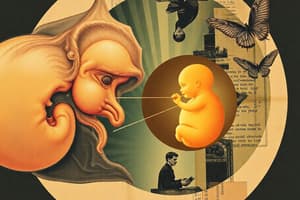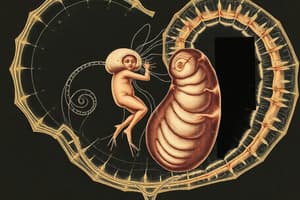Podcast
Questions and Answers
The receptor for Hedgehog (Hh) on neighboring cells is called ______.
The receptor for Hedgehog (Hh) on neighboring cells is called ______.
Patched
MicroRNA (miRNA) is processed by ______ to form double-stranded RNA.
MicroRNA (miRNA) is processed by ______ to form double-stranded RNA.
Dicer
Let-7 miRNA plays a crucial role in cell differentiation and is linked to ______ when overexpressed.
Let-7 miRNA plays a crucial role in cell differentiation and is linked to ______ when overexpressed.
cancers
GLD-1 represses translation in posterior cells by binding to ______ mRNA.
GLD-1 represses translation in posterior cells by binding to ______ mRNA.
In situ hybridization is used for ______ localization in fixed embryos or tissues.
In situ hybridization is used for ______ localization in fixed embryos or tissues.
Transplanting the dorsal lip of the blastopore in Xenopus laevis leads to the formation of a Siamese twin due to the induction of a secondary embryonic ______.
Transplanting the dorsal lip of the blastopore in Xenopus laevis leads to the formation of a Siamese twin due to the induction of a secondary embryonic ______.
Sonic Hedgehog (Shh) is responsible for reverse polarity and the formation of extra ______ in chick embryos.
Sonic Hedgehog (Shh) is responsible for reverse polarity and the formation of extra ______ in chick embryos.
Cis-acting mutations often result in dominant ______ due to their regulatory effects.
Cis-acting mutations often result in dominant ______ due to their regulatory effects.
Homeotic genes in Drosophila control the identity of ______ parts.
Homeotic genes in Drosophila control the identity of ______ parts.
The method known as In Situ Hybridization is used to detect mRNA ______.
The method known as In Situ Hybridization is used to detect mRNA ______.
Bicoid, expressed at the anterior, helps establish a gradient to activate anterior ______.
Bicoid, expressed at the anterior, helps establish a gradient to activate anterior ______.
Even-skipped is a pair-rule gene that affects ______-numbered segments in Drosophila.
Even-skipped is a pair-rule gene that affects ______-numbered segments in Drosophila.
The gene cluster known as Bithorax controls thoracic and ______ segments in Drosophila.
The gene cluster known as Bithorax controls thoracic and ______ segments in Drosophila.
Engrailed and Wingless are crucial in segment patterning, dictating anterior vs. ______ borders.
Engrailed and Wingless are crucial in segment patterning, dictating anterior vs. ______ borders.
Mutations in regulatory elements can affect the expression of Sonic Hedgehog (Shh) without altering the ______ region.
Mutations in regulatory elements can affect the expression of Sonic Hedgehog (Shh) without altering the ______ region.
Flashcards
Hedgehog (Hh)
Hedgehog (Hh)
A signaling molecule that acts as a paracrine factor, meaning it influences neighboring cells. It's produced by cells expressing the engrailed gene.
Patched (Ptc)
Patched (Ptc)
A receptor on the surface of cells that binds to Hedgehog, activating downstream signaling pathways. When it binds Hh, it triggers the production of another signaling factor called Wingless (Wg).
Feedback Loop
Feedback Loop
A regulatory mechanism where the product of a signaling pathway influences the expression of its own regulators, helping to maintain stable signaling levels.
MicroRNAs (miRNAs)
MicroRNAs (miRNAs)
Signup and view all the flashcards
GLD-1
GLD-1
Signup and view all the flashcards
Spemann's Organizer
Spemann's Organizer
Signup and view all the flashcards
Zone of Polarizing Activity (ZPA)
Zone of Polarizing Activity (ZPA)
Signup and view all the flashcards
Sonic Hedgehog (Shh)
Sonic Hedgehog (Shh)
Signup and view all the flashcards
Polydactyly
Polydactyly
Signup and view all the flashcards
Homeotic Genes
Homeotic Genes
Signup and view all the flashcards
Antennapedia Complex
Antennapedia Complex
Signup and view all the flashcards
Bithorax Complex
Bithorax Complex
Signup and view all the flashcards
Hox Genes
Hox Genes
Signup and view all the flashcards
In Situ Hybridization
In Situ Hybridization
Signup and view all the flashcards
Gap Genes
Gap Genes
Signup and view all the flashcards
Study Notes
Transplantation Experiments
- Dorsal Lip of Blastophore (Spemann's Organizer)
- Experiment: Transplant dorsal lip of blastophore to ventral region of recipient embryo.
- Observed two separate dorsal lips and induction of a secondary embryonic axis.
- Resulted in the formation of a Siamese twin in Xenopus laevis embryos.
Polydactyly
- Misexpression of Shh in atypical limb regions induces extra digits.
- Mutations in cis-acting regulatory elements controlling Shh expression (not coding region).
- Properties of Cis-acting Mutations:
- Phenotypes are often dominant due to regulatory effects in cis.
- Specific regulatory elements affected; other gene functions may remain normal.
Homeotic Mutants in Drosophila
- Homeotic Genes: Control the identity of body parts.
- Wildtype: One pair of wings on the second thoracic segment, haltere on the third.
- Bithorax Mutant: Wings develop on the third thoracic segment (misrepresentation of wing genes).
- Antennapedia Mutant: Legs develop where antennae normally are (misrepresentation of leg genes).
- Hox Genes: Two group of related genes that control the body plan of an embryo along the anterior-posterior axis.
- Comprises:
- Antennapedia (controls head and thoracic segments)
- Methods for Gene Expression Visualization
- In Situ Hybridization: Detect mRNA localization.
- Antibody-based: Detect protein expression and cDNA clones.
- Hox Gene Expression:
- Spatially restricted domains: Hox genes express early in embryogenesis, controlling segment identity.
- Mutagenesis screens (Wieschaus, Lewis, Nüsslein-Volhard): Discovered maternal and zygotic genes controlling Hox gene expression.
Drosophila Development: Gene Gradients
- Maternal Genes:
- Bicoid: Expressed at the anterior; establishes gradient to activate anterior genes.
- Nanos: Expressed at the posterior; creates gradient for posterior genes.
- Gap Genes:
- Krüppel, knirps, Giant, hunchback: Control large segment areas.
- Bicoid mutants: Missing anterior; Hunchback gene activated.
- Pair-rule Genes:
- Even-skipped: Affects even-numbered segments.
- Fushi tarazu: Affects odd-numbered segments.
- Stripe formation: Controlled by maternal and gap genes.
- Segment Polarity Genes: Dictate anterior vs. posterior borders of segments.
- Engrailed and Wingless: are key in segment patterning.
Studying That Suits You
Use AI to generate personalized quizzes and flashcards to suit your learning preferences.
Description
This quiz covers key experiments in embryology such as Spemann's Organizer and the effects of polydactyly through Shh misexpression. Additionally, it discusses homeotic mutants in Drosophila, particularly the mechanisms controlling body part identity. Test your understanding of these concepts in developmental biology.




